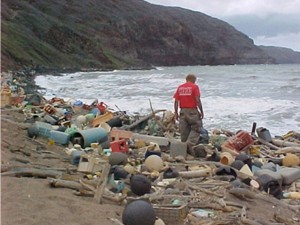Water Conservation
The Great Pacific Garbage Patch has grown more than 100-fold in four decades, with no sign of slowing down.
The Great Pacific Garbage Patch has grown more than 100-fold in four decades, with no sign of slowing down.
The Great Pacific Garbage Patch is a true testament to the ignorance of our modern world when it comes to the environment around us. As you take a swig from the BPA laced plastic water bottle that was brought back from the grocery store in a single use plastic bag, think about what happens when they are both tossed away. This discarded plastic and other litter often ends up in our oceans and thanks to strong ocean and wind currents it creates an enormous mass of floating plastic spanning thousands of miles. The lifestyle of wasteful convenience experienced in America and other industrialized nations has allowed the Great Pacific Garbage Patch to grow at an estimated hundred-fold in the past four decades.
 The Pacific Ocean has become the world’s largest landfill in an area known as the North Pacific Subtropical Gyre. This area boasts a slow moving group of spiral currents that create an oceanic desert with very little sea life. These currents also create an odd side effect, collecting floating trash from around the globe and focusing it in this one region. According to studies by the United Nations Environment program, it is estimated that every square mile of ocean contains 46,000 pieces of plastic, an alarming figure that has likely grown since the 2006 study. A significant portion of this garbage consists of small particles of plastic floating just beneath the surface, this makes measurements more difficult. Based on sampling data it is estimated that the Great Pacific Garbage path could make up 8.1 percent of the entire Pacific Ocean or 5,800,000 million square miles.
The Pacific Ocean has become the world’s largest landfill in an area known as the North Pacific Subtropical Gyre. This area boasts a slow moving group of spiral currents that create an oceanic desert with very little sea life. These currents also create an odd side effect, collecting floating trash from around the globe and focusing it in this one region. According to studies by the United Nations Environment program, it is estimated that every square mile of ocean contains 46,000 pieces of plastic, an alarming figure that has likely grown since the 2006 study. A significant portion of this garbage consists of small particles of plastic floating just beneath the surface, this makes measurements more difficult. Based on sampling data it is estimated that the Great Pacific Garbage path could make up 8.1 percent of the entire Pacific Ocean or 5,800,000 million square miles.
The infamous Japanese Tsunami caused enormous amounts of damage and ravaged the island nation, washing homes, businesses and lives out to sea. The debris from this tragedy is now caught up in the Pacific’s currents and is beginning accumulate, adding to the already littered Great Pacific Garbage Patch. The trash that isn’t stuck in the currents has also begun to wash up on the west coast of the United States in places such as Oregon, Washington and Alaska.
The obsession we have with single use plastics and other non-reusable items is the root cause for a large portion of this mess. Prevention is really the only logical step we can take at this point as clean-up measures would prove implausible. Instead we should implement some basic methods that can help curb the rapid growth of the debris field, allowing Mother Nature to work on cleaning up our existing mess. The following tips can help you take action in preventing the spread of the Great Pacific Garbage patch and help create a sustainable earth at the same time.
I am a father of three and I often wonder what shape the planet will be in when we pass it along to the next generations. The Great Pacific Garbage, sadly, was preventable, though our desire for convenience and money led us to poor decision making over the past few decades. Let’s take a lesson from our previous generations and think about using products that last and put our kids first, not our portfolio.
Reply to Volunteer Bill Cancel reply